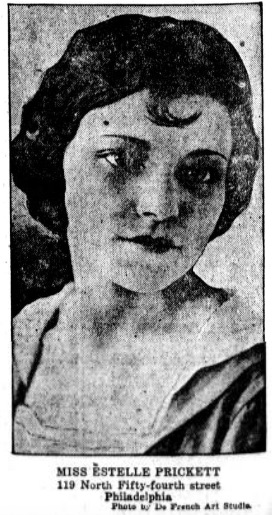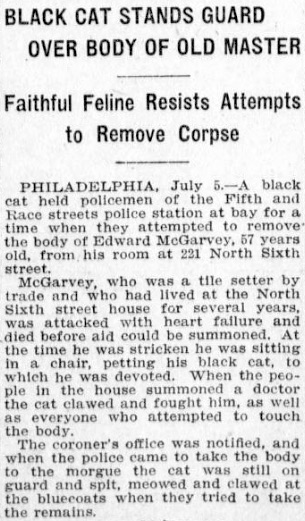
There is no doubt that Philadelphia has character and that a lot of weird and creepy things have happened there in the past. In the early 1900s, spiritualism was alive and well in Philly and people were fascinated by the dead. Before that, there was a healthy trade in dead bodies and human skeletons, and there were plenty of people getting rich off the dead.

People Liked Old Bones
In 1896, the skeletal remains of what looked like a mammoth were found in a quarry in West Philadelphia. According to the article:
“The skeleton was unearthed April 9th by workmen at Pemberton’s stone quarry at Fifty-fifth Street and Wyalusing Avenue. The men had put in a big blast, and after the smoke had cleared away they found a most curious state of affairs. The stone bank that had been disturbed evidently formed the front wall of a cave that ran back underground some thirty feet.”
A pit inside the cave contained four large tusks, a jaw, teeth, and other bones of the animal. There was also what looked like a human skeleton.
The bones were gathered up, removed from the cave, and put into a pile outside. Unfortunately, no guards were in place and as the news rang out of the skeletal remains, people came to check them out and to also grab a few for their personal collection. By the time a local museum curator arrived at the scene, there were very few bones left to take back to the museum for examination. [1]
The Savage Cats
“Savage Cats Guard Corpse” was the headline out of Philly back in 1914.
According to the police, they received a rather mysterious phone call telling them to go to the house of Sarah Lippincott Starr. When they arrived they found the old woman’s body clad in rags and on the floor. Five “savage” cats guarded the woman’s body and prevented the policemen from getting too close to it.
While the article does not say how they managed to scare off the cats, it did state that they located the woman’s sister. She claimed that Sarah must have died from septicemia after having been pricked by a pin.
No further investigation was made into the death or the phone call. [2]
This, of course, was not the first time a cat had guarded a body in Philadelphia:

The Philadelphia Body Snatcher Gang
In 1882, members of a gang of body snatchers were arrested. According to one article, one cemetery’s records showed that in two months, fifty-five bodies had been buried in one gravesite, and the bodies were removed after each burial. One of the men from the gang also admitted that if extra bodies were needed, they would be taken out of the caskets in the receiving vault and that families were often burying empty caskets.
What was being done with all of these dead bodies? They were being sold to medical schools, such as Jefferson College, for dissection. One man admitted that he was getting paid $3 for each body he dug up, which was very good money for that time period. [3]
Kept His Body for Over Two Weeks
A Philadelphia cotton broker had terrible nightmares about his brother waking up in the grave and soon began to fear that he, too, might get buried alive. In order to prevent such great misfortune, Andrew J. Turner made his wife and daughter promise not to bury him for a full two weeks after his death, just in case he might be truly alive.
Turner passed away in 1913 and his wife honored his last request. For over two weeks she kept his body in their upscale home. Neighbors complained and a family doctor had to constantly reassure the wife that there was no hope of her husband returning to life. She eventually conceded and allowed the undertaker to prepare her late husband’s funeral. [4]
A Big Vat of Bodies
It was a huge scandal in 1873. A wealthy man was fished out of the Schuylkill River and taken to the Philadelphia morgue. The man’s watch was soon discovered in a pawn shop and his friends found out that his chain, pocketbook, and all his papers were also missing.
The deputy coroner and morgue keeper were believed to have been involved in the theft, but what was worse was that the wealthy man’s body, supposed to have been buried in a casket, was also missing.
The police searched for the missing body in the most likely place – a medical school:
“In a vat filled with liquor, of the composition of which the officers were ignorant, they found twenty-five human beings, of every condition and of both sexes. They were held there in soak. The sight was revolting and sickening in the extreme. I defy any one other than a physician to look upon such a spectacle unmoved. [The bodies] were arranged in no particular order….The starved, the butchered and the suicidal in that immense vat together waited the keen point of the dissecting knife.”
The wealthy man’s body was removed from the spirit vat and was given a proper burial. [5]

Questioned a Corpse
In 1910, the people of the U.S. seemed to enjoy “humorous” stories involving corpses. For example, Louis Hahn, Jr., a Philly factory watchman, was making his rounds one night when he discovered his father’s body, also a watchman, hanging from a rope.
The son cut his father from the rope and carried the body to a phone booth where he was able to stand the body up in a corner. The police were called.
During the wait, the son went back inside the factory. When he returned to see if the police had arrived, he discovered a policeman questioning his father’s cbody about the location of the corpse.
It was a sad, unfortunate story, but it was also considered humor in the early 20th century. [6]
The Den of Skeletons
The human skeleton trade in the late 19th century was booming in New York City and Philadelphia. It involved taking human bodies, removing the meat from the bones, bleaching the bones, and putting the skeleton back together for display.
M. de Robaire owned a skeleton trade business “in the vicinity of Sixth and South Streets” where he sold perfumes on the first floor and skeletons on the second floor. His skeleton business was a bit of a secret, claiming that his neighbors simply would not understand or accept his trade. Indeed, if they knew that his bedroom was filled with skeletons, he would have been chased from his home:
“The walls of the small room are ornamented with skulls and crossbones, and real life-sized skeletons, or, rather, death-like skeletons, in all sorts of grotesque positions. Four hideous skulls grin from their positions on top of the four posts of the bed, and close to the sides of the bed stands a skeleton with arms outstretched doing duty as a clothes rack. The whole is dimly lighted up by a faint glimmer of light emanating from a lamp made of a ghostly skull suspended from the middle of the ceiling with thongs of tanned human hide.” [7]

